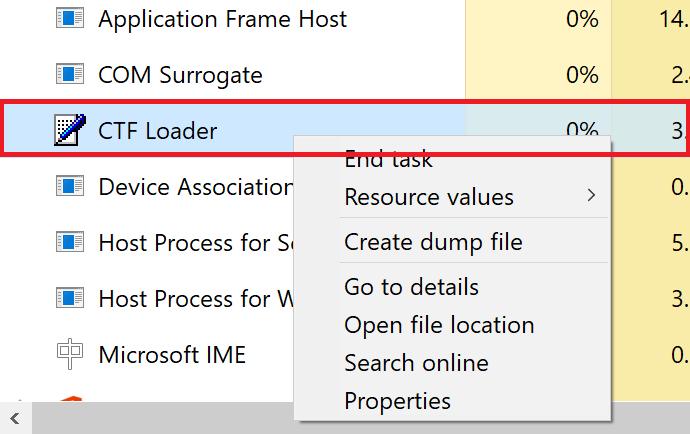Everyone should always make a habit of checking the task manager for a simple performance check. Now some people come across a ctfmon.exe (CTF Loader) running in the task manager, and then you might be wondering what this process is all about wondering if it’s a malware or not.
It is one of the executable files that sparks curiosity in the users, even if they aren’t affected in any way by it. The user must realize where this particular file originated and from which application might be troublesome for a lot of users. The ctfmon.exe file heavily relies on the Collaborative Translation Framework Loader. This particular service provides text support for handwriting and speech recognition.

Ctfmon.exe is one of those system files that need to be preoccupied with its functionality as it provides us the activation of the Alternate User Input Text Input processor along with the Microsoft Office Language Bar. This system file is frequently used. However, if this specific file keeps originating from different sources, we need to read this as a dangerous warning for our systems.
It is easy to identify whether this system file is a danger to the system or not. There can only be two cases possible in this scenario. The first one is when you use an application that actually needs the ctfmon.exe file to run, and the other one is when you are sure that you aren’t using any apps that originate this ctfmon.exe.
For example, using the handwriting mode in Windows 10, it is very ordinary to see this system file originate, but you need to take precautions if you identify this system file originating without any use.
Contents
How to Control CTF Loader
Method 1: Revert to the Older Windows Version
If this is one of the recurring errors, especially after updating Windows, we recommend you to revert to the older versions. Some Windows updates, while aiming to help our system run flawlessly, cause an issue with the CTF loader. It is obvious that we need to downgrade our Windows to check if this was the reason for the error. We can easily revert by:
Step 1: Pressing the Windows key.
Step 2: Selecting Settings.
Step 3: Choosing Update & Security and then Recovery.
Step 4: Find Click Get Started in the section.
Step 5: Go back to the previous version.
Method 2: Delete CTF Loader Files
Check the location C:\Windows\System32 or C:\Windows\SysWOW64. Either of this location will work depending on your system is 32-bit or 64-bit. Now you have to search for all ctfmon.exe files by searching for the same in the search bar of your file explorer.
Use Windows + E and then Windows + F shortcut to get a list of all the .exe files. Now, you have to get rid of all the ctfmon.exe files from the list except for the files present in the above-mentioned locations.
Method 1: Disable Touch Keyboard and Handwriting Panel
Sometimes the simplest solution is the most obvious solution and yet ignored by a number of users. Disabling the Touch Keyboard and Handwriting Panel service is the easiest method to get rid of the problem.
Step 1: Start Run using Windows + R
Step 2: Enter “services.msc”
Step 3: Navigate to a service named Touch Keyboard and Handwriting panel and select the same.
Step 4: Choose Disabled from the drop-down menu in the “Startup Type” section
Step 5: Click Apply then select Ok
Restart your system and it shouldn’t continuously run and hog the resources of your computer anymore. However, this particular method isn’t foolproof as it can affect the computer when the service is disabled. You might see that the Windows button can’t access the search menu, once you have disabled the service. In this case, revert back to enabling the service and move on to the next methods.
Method 2: Use Task Scheduler
Method 1 suggested can sometimes be counter-effective in its work. So, you can use Task Scheduler to control when the ctfmon.exe starts having to affect any service or getting rid of any file.
Step 1: Start “Run” using shortcut Windows + R
Step 2: Type taskschd.msc and press Enter
Step 3: Navigate to “Task Scheduler Library”.
Step 4: Find “Microsoft” and select the same
Step 5: Double click Windows and choose “TextServicesFramework”
Step 6: Right-click on the MsCtfMonitor. Then chose Disable (or any other trigger of your choice
Method 3: Scan your Computer
This is one of the solutions which you must have already tried. Even if you choose to go with any of the above methods, we highly recommend you to scan your device. It will take up a little time but it would be ensuring that the system is secure.
So, downloading an antivirus and malware detecting tools of your choice and running a full system scan can be one of the simplest solutions to this error. This guide is to download and use Malwarebytes, a popular malware detecting tool:
Step 1: Download the Malwarebytes for Windows.
Step 2: Once downloaded, run the downloaded security software and scan your system.
Conclusion
CTF Loader can be one of the reasons for the slow performance of your system and in today’s world, we need to keep up with the fast speed of technology and others. Make sure that your system is free of malware and is up to date. Follow these methods and ensure your system’s optimal performance.
Thank You For Reading!






























